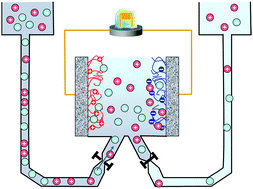Polyelectrolyte-coated carbons used in the generation of blue energy from salinity differences
Abstract
In this work we present a method for the production of clean, renewable electrical energy from the exchange of solutions with different salinities. Activated carbon films are coated with negatively or positively charged polyelectrolytes using well-established adsorption methods. When two oppositely charged coated films are placed in contact with an ionic solution, the potential difference between them will be equal to the difference between their Donnan potentials, and hence, energy can be extracted by building an electrochemical cell with such electrodes. A model is elaborated on the operation of the cell, based on the electrokinetic theory of soft particles. All the features of the model are experimentally reproduced, although a small quantitative difference concerning the maximum open-circuit voltage is found, suggesting that the coating is the key point to improve the efficiency. In the experimental conditions used, we obtain a power of 12.1 mW m−2. Overall, the method proves to be a fruitful and simple approach to salinity-gradient energy production.


 Please wait while we load your content...
Please wait while we load your content...